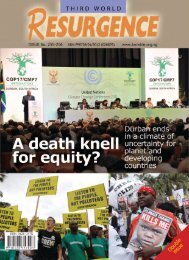Plantations, poverty and power - Critical Information Collective
Plantations, poverty and power - Critical Information Collective
Plantations, poverty and power - Critical Information Collective
You also want an ePaper? Increase the reach of your titles
YUMPU automatically turns print PDFs into web optimized ePapers that Google loves.
9<br />
plantations established on grassl<strong>and</strong>s have an impact on water supply is firmly established, in both<br />
scientific reports <strong>and</strong> even pro-plantation reports. A 1999 report by the Australian Bureau of Agricultural<br />
<strong>and</strong> Resource Economics <strong>and</strong> consulting firm Jaakko Pöyry states that:<br />
“In seasonally dry environments, trees <strong>and</strong> other l<strong>and</strong> uses compete for water. Some eucalypt plantations<br />
which have been established on natural grassl<strong>and</strong>s in Uruguay <strong>and</strong> South Africa have been found to affect<br />
the availability of local water by lowering watertables. Creeks <strong>and</strong> wells have dried up, requiring local<br />
people to travel further to obtain water. Further, insecticide <strong>and</strong> fertilisers used in plantation management<br />
can affect the quality of local water supplies <strong>and</strong> aquatic fauna.” 10<br />
The vast areas of industrial tree plantations established in Brazil are monocultures – the very opposite of<br />
biological diversity. E.O. Wilson, a biologist at Harvard University, describes the effects of plantations on<br />
biological diversity as the equivalent of “building a line of Wal-Marts”. 11<br />
The industrial tree plantations which feed the pulp <strong>and</strong> paper industry do not sequester carbon dioxide.<br />
The fibre is used to make paper, a hugely energy intensive process to manufacture a product which is<br />
often thrown away. The majority of the world’s paper ends up in l<strong>and</strong>fill dumps where it rots <strong>and</strong><br />
produces methane, a gas which is 21 times as potent a greenhouse gas as carbon dioxide. The largest<br />
single source of greenhouse gases from the Canadian forestry industry is methane emissions from rotting<br />
paper <strong>and</strong> other forest products in l<strong>and</strong>fills. In 2005 such emissions accounted for about 46 per cent of the<br />
industry’s greenhouse gas emissions. 12<br />
<strong>Plantations</strong> do not relieve pressure on native forests. The pulp <strong>and</strong> paper industry prefers fibre produced<br />
from fast growing eucalyptus plantations. As Leonel points out in his presentation, no pulp <strong>and</strong> paper is<br />
produced from native forests in Brazil. But if plantations were really relieving the pressure on native<br />
forests, the rate of deforestation should be decreasing as the area of plantations is increasing. This is not<br />
happening in Brazil, which has both large areas of plantations <strong>and</strong> high rates of deforestation. “To date,<br />
however, plantations have had no discernible global impact on reducing deforestation,” notes an article by<br />
two World Bank staff, Jürgen Blaser <strong>and</strong> Jim Douglas. 13 Many of the causes of deforestation – such as<br />
road-building, conversion to soya bean or oil palm plantations, or the flooding of forest for large-scale<br />
hydro<strong>power</strong> dams – have nothing to do with supplies of timber. Timber from native forests is often in any<br />
case destined for a different market to that from fast-growing industrial tree plantations – for furniture or<br />
construction, for example.<br />
And Leonel’s presentation makes no mention of the fact that pulp mills are one of the most polluting of<br />
industrial processes. All over the world, local communities have protested about the pollution caused by<br />
pulp mills. Health risks include cancer, lung diseases, reproductive <strong>and</strong> hormone problems, heart disease,<br />
10 Abare <strong>and</strong> Jaakko Pöyry (1999) “Global Outlook for <strong>Plantations</strong>”, Abare Research Report 99.9, Australian Bureau of<br />
Agricultural <strong>and</strong> Resource Economics, Canberra, page 35.<br />
11 Ted Williams (2000) “False Forests”, Mother Jones, 1 June 2000.<br />
http://forests.org/archived_site/today/recent/2000/falsefor.htm<br />
12 “The Greenhouse Gas <strong>and</strong> Carbon Profile of the Canadian Forest Products Industry”, Special Report No. 07-09, National<br />
Council for Air <strong>and</strong> Stream Improvement, 2007. http://www.ncasi.org//publications/detail.aspxid=3013<br />
See also Chris Lang (2007) “The paper industry <strong>and</strong> the ‘business of climate change’”, World Rainforest Movement<br />
Bulletin no. 125, December 2007. http://chrislang.org/2007/12/20/the-paper-industry-<strong>and</strong>-the-business-of-climate-change/<br />
13 “World Bank foresters deny that plantations alleviate pressures on forests”, World Rainforest Movement Bulletin no. 41,<br />
December 2000. http://www.wrm.org.uy/bulletin/41/plantations.html















